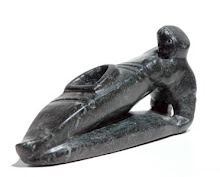t These past days, a sizable chunk of my spare time has been spent tenaciously sliding a bench plane back and forth over strips of sandpaper of varying coarseness. It may not be readily apparent to the general public, but I am actually involved in a very respectable ceremony called, I believe, "Planing the Sole". It happens to be just one part of a series of arcane rituals destined to ready woodworking tools for action.

You see: I hope to build a Greenland paddle for myself (inevitably, more on this sometime soon). Such a project requires adequate wood, working space and tools. Wood has been located and ordered, working space improbably produced and tools (or, rather, what may become tools) bought. Woodworking skills may be needed as well, but, as I totally lack any woodworking experience, I try not to dwell on that too much. It would dampen my spirits and, as I fear that the challenges that I vaguely suspect await a novice woodworker will do that anyway, I see no need to rush it. Every thing in its due time.
Fortunately, the useful
Kayak de Mar Forum is visited by a number of benign woodworking gurus. They kindly impart their wisdom upon the likes of me and, thus, I've deduced that buying artful contraptions is only the beginning to obtaining real, work-worthy tools. From their teachings, I've learned of the existence of the "tools-you-can-trust-and-actually-enjoy-using". Mythical objects that must be earned, not just bought, and for which money may just be a minor part (well, relatively) of what you have to pay.

And this is how, for about a week now, my free moments have been spent doggedly planing soles and honing blades. Early success with a Stanley spokeshave possibly bred undue confidence. I suppose the glitter of metal smoother and sharper than I thought I could possibly produce can do that to those, like me, new to the experience. However, the #4 bench plane of the same brand has decided that it will not submit without a fight.
The sources of instruction mentioned above have informed me that a plane's sole simply *must* be incredibly level and smooth in, at least, 3 critical areas. Makes lot of sense, as the tool's purpose is to give you flat and smooth wood. However, luck and mass production have conspired to place the deepest of the pockets and irregularities of my plane's original sole in precisely one of these critical locations. It just can not be ignored. Therefore, I'm being forced to sand away pretty much the whole sole surface till everything is level with the furthest point of the rebellious recess. It may not sound like much, but, by hand, it is a respectable amount of metal to thin and it is taking its time.
Fine with me, though. Wolves had to be tamed to become dogs. Colts have to be broken. I can be patient. I have a past as an angler.
Plus, there are benefits: I am thoroughly committing to muscle memory the motions of planing, the exercise builds character and it should also serve as cautionary example to the block plane (a Stanley too) that comes next.

And then, the builders in the Arctic produced not just paddles, but whole boats and all sorts of useful gear (often beautiful too) with little more than the tools illustrating this post. However, I suspect that what surgical precision their instruments may have lacked, they amply made for with skill gained through a lifetime of mentoring by elders and practice. At this stage of my life, I do not think I can conveniently reproduce those conditions (I'd like to have my paddle while I still can use it). So, I have to go for tool-taming and hope for the best.
THE IMAGES
Click on them to learn more about the Inuit tools they depict in their pages in the site of the
McCord Museum. A kindly institution that represents a terrific resource for graphically-depreived bloggers like me















